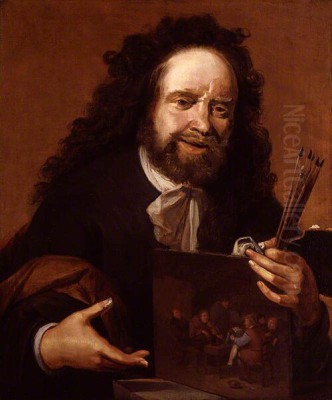
Egbert van Heemskerck the Elder stands as a distinctive figure within the rich tapestry of Dutch Golden Age painting. Active during the latter half of the 17th century and into the early 18th century, he carved a niche for himself through lively, often humorous, and sometimes biting depictions of everyday life, particularly scenes set in taverns, peasant cottages, and even surgical theatres. His work bridges the Dutch tradition of genre painting with the burgeoning market for satirical art in late Stuart and early Hanoverian London, where he spent the latter part of his career.
Often identified by the patronymic "Jaspersz." (son of Jasper), his full name helps distinguish him from other artists named Heemskerck, most notably the much earlier and highly influential Maarten van Heemskerck (1498–1574), to whom he was not directly related in a father-son capacity. He must also be differentiated from his own son, Egbert van Heemskerck the Younger (or II), who followed in his father's footsteps as a painter, often working in a similar style. Understanding Egbert the Elder requires appreciating his roots in the Dutch artistic milieu and his later adaptation to a different cultural and commercial environment in England.
Early Life and Artistic Formation in Haarlem
Egbert van Heemskerck the Elder was likely born in Haarlem, a major centre for painting in the Dutch Republic, around 1634 or 1635. Some sources suggest The Hague as his birthplace, but Haarlem is more consistently associated with his formative years and training. His father was Jasper Jaspersz. van Heemskerck, a medical doctor. This familial connection to the medical profession undoubtedly provided Egbert with unique insights and access, profoundly influencing a significant portion of his artistic output later in life. Growing up in a doctor's household likely exposed him to the realities of illness, injury, and medical practice in the 17th century.
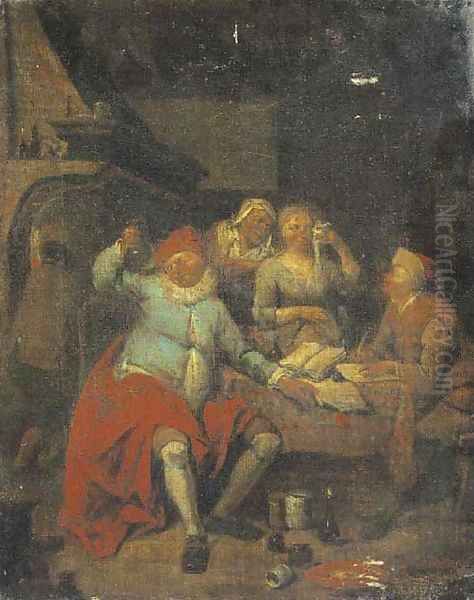
He received his artistic training in Haarlem, immersing himself in the city's vibrant artistic environment. While the specific masters under whom he studied remain uncertain, it is clear he absorbed the prevailing trends in Dutch genre painting. Some historical accounts have erroneously linked him as a pupil to the famous Jan van Scorel, but this is chronologically impossible, as van Scorel died decades before Heemskerck was born; this confusion likely arises from association with the earlier Maarten van Heemskerck, who was van Scorel's student. It is more probable that Egbert the Elder learned his craft from local Haarlem masters specializing in genre scenes, developing his skills in composition, figure drawing, and the depiction of interiors.
The artistic atmosphere of Haarlem in the mid-17th century was dominated by figures like Frans Hals, renowned for his dynamic portraits, and genre painters such as Adriaen van Ostade and Adriaen Brouwer (though Brouwer worked primarily in Antwerp, his influence was felt in Haarlem). Heemskerck's work shows a clear affinity with the peasant scenes and tavern interiors popularized by Ostade and Brouwer, focusing on the lives of ordinary people, often depicted with energy and a lack of idealization.
Artistic Style: The Dutch Genre Tradition
Egbert van Heemskerck the Elder worked firmly within the Dutch genre tradition, specializing in scenes of everyday life, often referred to as "low-life" subjects. His canvases teem with activity, typically set in dimly lit interiors like taverns, rustic cottages, or guardrooms. He depicted peasants, soldiers, and townspeople engaged in various activities: drinking, smoking, playing cards, quarrelling, dancing, or simply conversing. His approach was generally realistic in its detail but often exaggerated for humorous or dramatic effect.
Compared to the more refined genre scenes of artists like Gerard Dou or Johannes Vermeer, Heemskerck's work is characterized by its earthiness and dynamism. His figures are often robust, even caricatured, with expressive faces and animated gestures. He shared this focus on the boisterous and unvarnished aspects of life with contemporaries like Jan Steen, who also excelled at depicting chaotic household scenes and tavern revelry, often imbued with moralizing undertones. However, Heemskerck's humour could often lean more towards the satirical or even the grotesque.
He paid close attention to the details of setting and costume, rendering textures of wood, earthenware, and rough fabrics effectively. His use of light and shadow, often employing chiaroscuro techniques, helped to create atmospheric interiors and highlight key figures or actions within the composition. While sometimes criticized for a certain crudeness in execution or a palette that could be perceived as sombre or "cold," his paintings possess an undeniable vitality and narrative energy that made them popular.
Medical Themes: A Unique Specialization
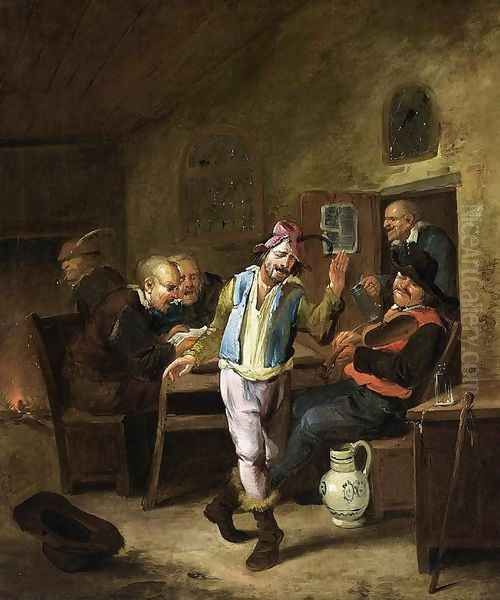
One of the most distinctive aspects of Egbert van Heemskerck's oeuvre is his recurring depiction of medical and surgical scenes. Drawing inspiration from his father's profession, he painted numerous works set in doctors' offices, surgeons' practices, and apothecary shops. These paintings offer fascinating, if sometimes unsettling, glimpses into 17th-century medical practices. Works like The Doctor's Surgery (or A Surgeon's Practice) are prime examples of this thematic focus.
These scenes are often depicted with a dramatic intensity. A surgeon might be shown performing a crude operation, perhaps a bloodletting or tending to a wound, surrounded by anxious onlookers or assistants. The settings are typically cluttered with the tools of the trade: jars, bottles, surgical instruments, books, and anatomical charts or skeletons. Heemskerck did not shy away from the grim realities of pre-modern medicine, often including elements that underscore the precariousness of life and the limitations of contemporary medical knowledge.
Symbolism frequently plays a role in these works. Skulls, hourglasses, or extinguished candles might appear, serving as memento mori – reminders of mortality. These symbols, combined with the often tense or painful scenarios depicted, create a complex commentary on healing, suffering, and death. While Rembrandt van Rijn tackled medical subjects in a more formal and monumental manner with works like The Anatomy Lesson of Dr. Nicolaes Tulp, Heemskerck's approach was more intimate, narrative-driven, and often tinged with a sense of morbid curiosity or even dark humour.
Humour, Satire, and the Grotesque
Beyond straightforward genre scenes and medical depictions, Egbert van Heemskerck demonstrated a strong inclination towards humour, satire, and occasionally the bizarre or grotesque. He was known for painting "drolleries" – amusing or whimsical scenes often featuring peasants in comical situations, monkeys mimicking human behaviour, or fantastical elements. Tavern brawls, card games ending in disputes, and scenes of excessive drinking were common subjects, treated with an eye for absurdity.
His satirical edge became particularly prominent in works produced later in his career, especially after his move to London. He tackled social and political themes, sometimes depicting specific events or types. A notable example is his painting of the tumultuous Oxford City Council election of 1687, capturing the chaos and contention of the event in his characteristic style. He also painted scenes involving witchcraft, alchemy, or encounters with ghosts, tapping into popular folklore and anxieties of the time.
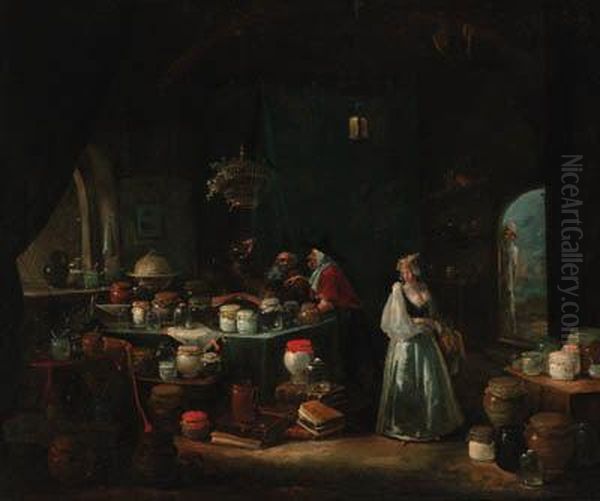
This satirical and sometimes coarse humour connects him to a lineage extending back to earlier Netherlandish artists like Pieter Bruegel the Elder, who masterfully blended depictions of peasant life with social commentary and moral allegory. Heemskerck adapted this tradition to his own time and, eventually, to the English context, where satirical prints and paintings were gaining popularity. His willingness to engage with the less refined aspects of human behaviour set him apart from artists focused on more decorous subjects.
Move to London and English Career
Sometime probably in the 1670s or 1680s, Egbert van Heemskerck the Elder relocated from the Netherlands to London. The exact reasons and timing are not precisely documented, but this move marked a significant shift in his career. England, particularly London, offered a different market for artists. There was a considerable appetite among English patrons and the burgeoning middle class for Dutch and Flemish style paintings, especially genre scenes, landscapes, and still lifes.
Heemskerck found considerable success in London, catering to this taste. His established style, depicting lively tavern scenes, peasant interiors, and satirical subjects, resonated with English audiences. He continued to produce works in his characteristic manner, and his paintings were widely collected. His presence in London contributed to the popularization of Dutch-style genre painting in England.
His son, Egbert van Heemskerck the Younger (c. 1676–1744), also worked as a painter in London, often imitating his father's style and subjects. This has sometimes led to confusion in attributing works between the two. The father, Egbert the Elder, remained in London until his death in 1704. His later works often reflect his English environment, such as the aforementioned Oxford Election or depictions of specific English types or customs, like his well-known painting The Quakers' Meeting. This latter work, depicting a Quaker religious gathering, was reproduced in prints and became quite famous, though its portrayal likely catered to mainstream Anglican curiosity or even prejudice towards dissenting groups.
Contemporaries and Influence
During his career in both the Netherlands and England, Egbert van Heemskerck the Elder operated within a network of artistic influences, collaborations, and rivalries. In Haarlem, he would have been aware of the work of leading genre painters like Adriaen van Ostade, Cornelis Bega, and perhaps the younger Richard Brakenburgh. His style clearly aligns with the earthy realism and focus on peasant life seen in Ostade and Bega. He also shared thematic ground with Jan Steen, though Steen's compositions are often more complex and overtly moralizing.
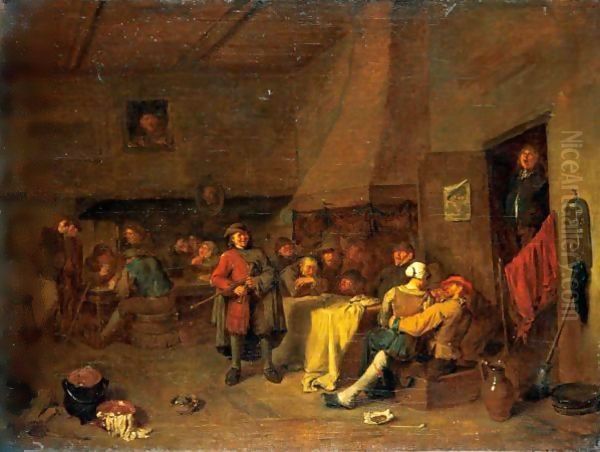
The provided source text mentions a competitive relationship with a cousin, Jasper Jaspersz van Heemskerck, who specialized in portraiture. This highlights the different paths artists within the same extended family might take. While Egbert focused on genre and satire, Jasper pursued a different, perhaps more conventional, market.
In London, Heemskerck's work found a place alongside imported Dutch and Flemish paintings and the work of immigrant artists like himself. His success suggests his style met a demand not fully catered to by native English painters at the time. His satirical and humorous genre scenes are often seen as precursors to the great English satirical artists of the 18th century, most notably William Hogarth. While a direct line of tutelage is unlikely, Heemskerck's popular depictions of contemporary life and manners, often with a critical or comical edge, helped pave the way for Hogarth's more elaborate "modern moral subjects."
His relationship with printmaking is also significant. While not primarily known as an engraver himself, his paintings were frequently copied and disseminated as prints by engravers, particularly in England. Figures like John Smith and possibly others helped to popularize his compositions, making his imagery accessible to a wider audience beyond those who could afford original paintings. This reproduction was crucial to his fame and influence. The earlier mention of collaboration with Dirck Volkertsz. Coornhert is incorrect, as Coornhert was associated with Maarten van Heemskerck a century earlier.
Historical Evaluation and Legacy
Egbert van Heemskerck the Elder occupies a specific and noteworthy place in art history. He was a prolific and popular painter of genre scenes, whose work provides vivid documentation of 17th-century life, particularly its less formal aspects. His depictions of taverns, peasant homes, and medical practices offer valuable insights into the social customs, living conditions, and professional activities of the period.
His artistic merit lies in his energetic compositions, his keen observation of human behaviour, and his often-effective use of humour and satire. While his technique might lack the refinement of some of his Dutch contemporaries like Vermeer or Dou, and his colour palette was sometimes deemed harsh, his work possesses a raw vitality and narrative power. He successfully adapted the Dutch genre tradition for the English market, contributing significantly to the taste for such scenes in late 17th and early 18th century England.
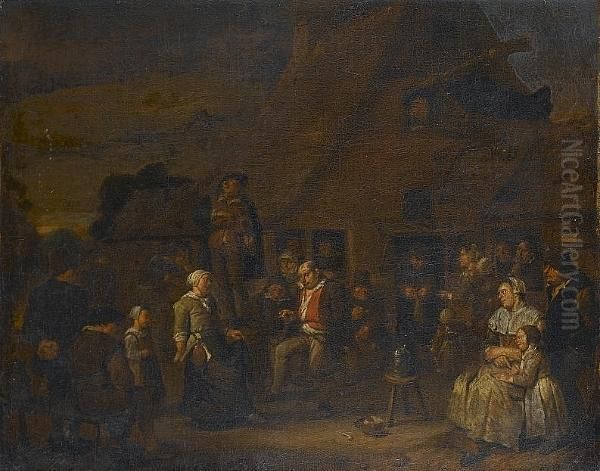
His specialization in medical scenes, informed by his family background, adds a unique dimension to his oeuvre, distinguishing him from many other genre painters. Furthermore, his satirical works connect him to broader European traditions of social commentary through art and position him as an important forerunner to the golden age of English satire in the following century.
His legacy is perhaps twofold: as a capable and distinctive practitioner within the Dutch Golden Age genre tradition, and as a key figure in transmitting that tradition to England, adapting it with a satirical flavour that resonated with his adopted audience. His works are held today in numerous museum collections, including the Rijksmuseum in Amsterdam and the Tate in London, ensuring his contribution to art history is remembered. He stands alongside figures like David Teniers the Younger and Adriaen Brouwer as a master of depicting the vibrant, often unruly, life of the common people. His engagement with contemporary society, whether through humour or critique, marks him as more than just a painter of scenes; he was an active commentator on the human condition of his time.